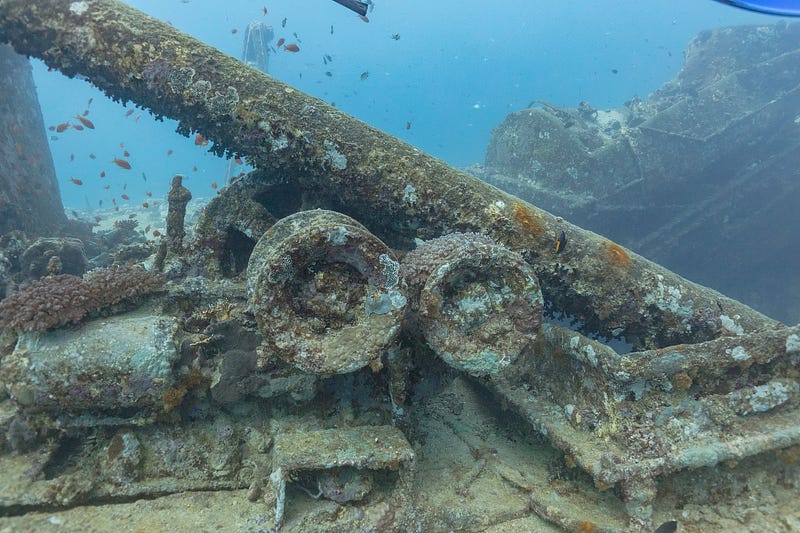Transforming Shipwrecks into Vibrant Underwater Ecosystems
Written on
Chapter 1: The SS Thistlegorm's Metamorphosis
The transformation of the SS Thistlegorm into a flourishing underwater ecosystem has captivated researchers. After eight years of extensive study in the Red Sea, scientists uncovered how this sunken vessel evolved into an artificial coral reef, now teeming with life akin to that found in natural reefs.
This paragraph will result in an indented block of text, typically used for quoting other text.
Section 1.1: Underwater Wonders
Diving videos of the SS Thistlegorm unveil a stunning aquatic landscape. Schools of vividly colored fish dance around the ship's anti-aircraft guns, which remain on the bow. The Red Sea’s exquisite corals are spread across the deck, while the entire structure and surrounding waters are alive with diverse marine organisms.
Explore the beauty of the SS Thistlegorm and its vibrant marine life in this captivating video.
Section 1.2: A Diverse Ecosystem
For divers exploring the wreck, larger fish can be found inside the hold. Unique species such as the Napoleon fish (Cheilinus undulatus) and giant moray eel (Gymnothorax javanicus) make appearances, adding to the allure. Divers must also pay attention to the ship's cargo, which includes rows of motorcycles, transport vehicles, and even trucks, all blanketed by a layer of silt.
Join a dive into the world’s second-largest shipwreck, the USNS Vandenberg, and witness the extraordinary underwater sights.
Chapter 2: The Journey of the SS Thistlegorm
The SS Thistlegorm's transformation into an underwater paradise took only a few decades. Originally a British transport ship during World War II, it sank in 1941 during its fourth voyage while carrying crucial supplies for British forces in North Africa.
After departing from Glasgow, the vessel navigated around Africa, passed Madagascar, and entered the Red Sea, aiming for Alexandria. Tragically, on October 6, the ship was bombed by German aircraft, leading to its demise. Today, it rests at depths ranging from 16 meters at the stern to 33 meters at the bow, making it a popular diving destination since the 1990s, located just 70 km from the resort town of Sharm el-Sheikh.
Section 2.1: Research and Findings
The wreck’s appeal to divers prompted scientific investigation. A project initiated by marine biology experts from the University of Bologna commenced in 2007, lasting eight years to gather data on the marine species inhabiting the wreck. Volunteers participating in the "Scuba Tourism for the Environment" program helped document the diverse life forms that made the SS Thistlegorm their home.
The researchers aimed to understand the ecosystem’s diversity, identifying 72 different taxonomic groups prevalent in the major ecosystems of the Red Sea. They conducted surveys with divers to determine the presence of various species.

Section 2.2: The Role of Artificial Reefs
The research revealed that over the years, the wreck has developed into a rich artificial coral reef. A remarkable 71 of the 72 identified taxa have been observed in the area. The researchers noted, “The SS Thistlegorm serves as a crucial case study demonstrating how a complex ecosystem, akin to natural reefs, can arise and thrive around artificial structures,” as detailed in their publication in the journal PLOS One.
These findings emphasize that studying artificial reefs like the SS Thistlegorm can inform efforts to protect natural reefs that are increasingly threatened by climate change. With an estimated three million shipwrecks scattered across the ocean floors, their presence can significantly affect delicate marine ecosystems. Many wooden ships have evolved into habitats for microorganisms, contributing to the marine food chain.
In recent studies, scientists discovered that various microorganisms, including bacteria and fungi, flourish on submerged vessels, turning them into vital shelters for an array of marine life.
Source: PLOS One
“Frightening” discovery on an isolated island. Researchers found plastic rocks
Will plastic rocks appear on beaches more and more often? This is already another example of how people are destroying…
Cool that you made it to the end of this article. I will be very pleased if you appreciate the effort of creating it and leave some claps here, or maybe even start following me. It would be nice if you also left a tip! Thank you!